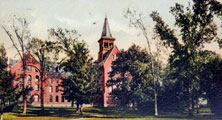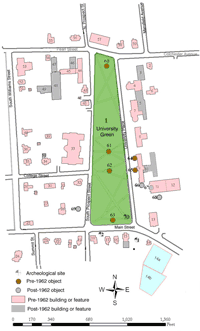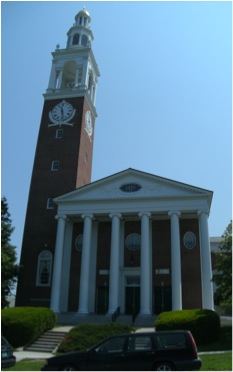 |
University Green Area Heritage StudyHistoric Burlington Research Project - HP 206Historic Preservation Program - University of Vermont |
Ira Allen Chapel
The Chapel is named after the founder of the state of Vermont and the University of Vermont, Ira Allen, at the behest of the main financier James Wilbur. Ira Allen Chapel is undoubtedly a contributing piece of architecture to the Green; although it is no longer used for religious purposes it has quite a history of hosting interesting speakers and university events. There is also an interesting contextual dynamic regarding the reasons for the adamant attitude of the man, James Wilbur, who financed the project. Ira Allen Chapel is an admirable example of the capabilities of the architects McKim, Mead and White. These architects designed everything from churches to power generators to picture frames; and they were "entrusted with the restoration of the most venerable sites, including Thomas Jefferson's University of Virginia and the White House in Washington, D. C".(5) Some of the "ambitions" that these architects were capable of attaining included "higher levels of services, greater cultural opportunities, and enhanced physical beauty" in innovative ways regarding structural design. Many of these "ambitions" were "realized in the growth of great public museums, libraries, and concert halls, the expansion of colleges, research universities, and hospitals…" that was happening at the time.(6) They contributed to other buildings on UVM's campus such as the Waterman Building. Ira Allen Chapel is a noteworthy contribution to the larger evolutions of culture as demonstrated through architecture in America at the time of its creation and holds its own individual value as being a part of the family of works of McKim, Mead, and White. In regards to Allen, the man for whom the chapel was named, there is a bit of a tragic tale. Evident in the title of chapter one in the book, The University of Vermont: the First Two Hundred Years, "A Hard Founding Father to Love" the University had a tumultuous relationship with Allen.(7) Allen's life seemed to be grounded in habits of bad investments and misfortune. Although he was responsible for founding Vermont's university in 1791, Daniels wrote that it was in a state of "turmoil" and because of relationships that continued to deteriorate with Quebec, England, and France he seemed to pay little attention to his brainchild, UVM.(8) In terms of money, the general assembly of the University became "spectacle of his prospects"; he was deeply indebted to Quebec and Vermont and had no cash or earning to settle with Vermont or the University, "his financial empire was awash with red ink."(9) He did not follow through on the initial financial promises he had made to the University, and even got arrested for a period time and was locked up abroad; during this period anything he had attained within his "Champlain Empire" was ruined. The University thus moved forward without him, his "inability to make good on any of his UVM pledges was evidence in the sorry state of [his] affairs".(10) Unfortunately, this seemed to not only be true in regards to his relationship with UVM, but his entire life, and "as UVM's star rose, Allen's descended" his "last years were unsuccessful and unhappy"; Even more painstaking is the fact that the further removed Allen became from UVM, the more UVM seemed to grow, and his memory "faded at UVM as the University developed a sense of its own history…" excluding him altogether.(11) For many years, Allen's adverse reputation must have preceded him, because no one seemed to feel the need to reestablish his presence until 1892. John Goodrich, an active member in the University's community, first attempted to rehabilitate Allen's reputation during the centennial celebration at the 1892 commencement by giving an address that highlighted the positive affects this community had experienced as a result of the founding father.(12) He also established "Founder's Day", May 1st (Allen's Birthday), which he described as "'a holiday forever, significant at once of her origin, and of the new life pulsing continually in her veins of perennial and ever burgeoning prime'".(13) Goodrich's efforts were continued into the 20th century by James B. Wilbur, an enthusiastic antiquarian that retired to Vermont and devoted himself to collecting and studying all things Ira Allen.(14) He became convinced it was "a sacred duty to undertake the writings of his [Allen's] life" and also UVM as an "object of charitable largesse" as a result of his intense devotion to Allen.(15) Wilbur became the University's principal benefactor; in 1921 he donated the bronze statue of Allen, and over the next few years he paid for the construction of Ira Allen Chapel, a chapel he would not have paid for if it was not guaranteed to be in the founder's name.(16) This intense reverence is the only reason that this chapel is standing and also the reason it is named after Ira Allen. Ironically, it was built not only to commemorate the founder, but as an act of vindication; if Allen had not lived such a tumultuous life, perhaps there would have never been a reason for a man to passionately feel the need to absolve him with a memorial chapel. Wilbur "convinced himself" that Allen was the "true hero" of Vermont and UVM. He wrote his biographies, collected his literature, and all matter of Vermontiana and Allen and donated this extraordinary library to the University.(17) Also, upon his death in 1929, Wilbur donated around three million dollars to the University which is still "the largest bequest in the University's history".(18) In Daniels' description of how the president of the University accepted the terms regarding Ira Allen Chapel, it seemed as if the President was not exactly thrilled about it. But, as demonstrated in Wilbur's continued generosity, it is obvious that while the President may have not been personally fond of Allen, his intentions were definitely in the University's best interest. Accordingly, Ira Allen Chapel represents a very dynamic and dichotomous history surrounding the founding of the University. This one building is representative of the good and the bad, so to speak, of its founder. If Allen had not been the sketchy character that he was then there would have never been a reason for one man, let alone two (Goodrich and Wilbur), to feel the need to exonerate him. Wilbur especially would have had no reason to go to such extraordinary lengths to make sure Allen was not forgotten. Equally important to note is that, because the University's founding father was exactly the man he was, the University made pre-emptive decisions to eradicate Allen from its evolution, which essentially resulted in its success. Although UVM did not exactly benefit from Allen in his day, the inspiration his life ignited in others, such as Wilbur, still brought prosper and betterment to the University and its community. Ira Allen Chapel, as a building on the Green, is a standing embodiment of the tragic tales of Allen, the success of the University against adversity, and the undying admiration for perseverance as it continues to house important university activities and functions. Image and text by Christine Prevolos, 2011 (1) David J. Blow, Historic Guide to Burlington Neighborhoods, (Burlington, VT: Chittenden County Historical Society, 1991), 182. (2)In celebration of the centennial year of the Billings Library and the diamond jubilee of the Ira Allen Chapel: dedication ceremonies of the Billings-Ira Allen Campus Center, (Burlington, VT: Queen City Printers, 1986), pamphlet with no page numbers. (3)In celebration of the centennial year of the Billings Library and the diamond jubilee of the Ira Allen Chapel: dedication ceremonies of the Billings-Ira Allen Campus Center, (Burlington, VT: Queen City Printers, 1986), pamphlet with no page numbers. (4)In celebration of the centennial year of the Billings Library and the diamond jubilee of the Ira Allen Chapel: dedication ceremonies of the Billings-Ira Allen Campus Center, (Burlington, VT : Queen City Printers, 1986), pamphlet with no page numbers. (5)Samuel G. White, McKim, Mead & White: the masterworks / Samuel G. White, Elizabeth White; photographs by Jonathan Wallen (New York: Rizzoli, 2003), 9. (6)White, 9. (7)Robert V. Daniels, The University of Vermont: the first two hundred years, (Hanover, NH: University of Vermont: Distributed by the University Press of New England, 1991). (8)Daniels, 20. (9)Daniels, 26. (10)Daniels, 28, 29. (11)Daniels, 30, 31. (12)Daniels, 32. (13)Daniels, 32. (14)Daniels, 33. (15)Daniels, 33. (16)Daniels, 33. (17)Daniels, 214. (18)Daniels, 33. |

